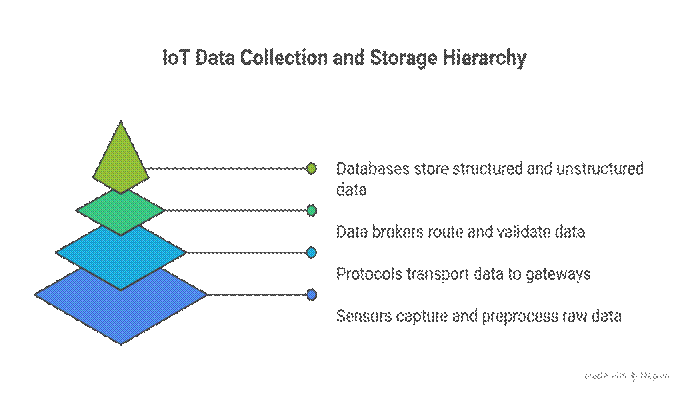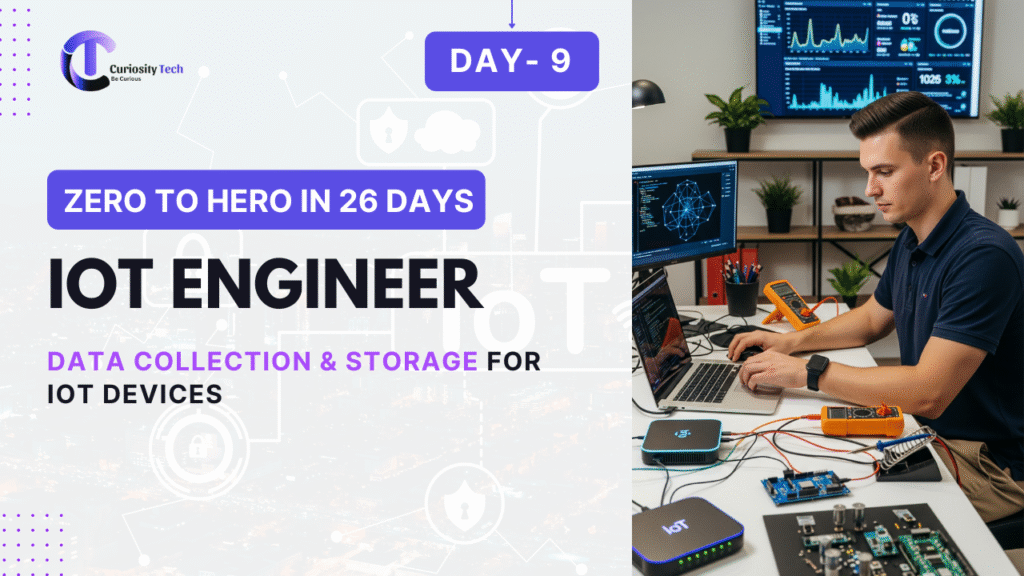Abstract
The exponential growth of IoT in 2025 has led to trillions of daily data transactions generated by connected devices across industries. Efficient data collection and storage architectures have become critical for ensuring reliability, scalability, and actionable value. This paper-style guide explores methodologies for IoT data gathering, critical storage frameworks (both at the edge and in the cloud), challenges of data accuracy and security, and real-world applications. Examples from smart agriculture, healthcare, and industrial domains highlight how optimized collection pipelines transform raw sensor data into meaningful insights.
Introduction
IoT devices, ranging from wearables to industrial machines, constantly generate telemetry data: temperature, vibration, moisture levels, heart rate, GPS coordinates, and more. This firehose of information is valuable only if:
- Collected efficiently with minimal energy overhead.
- Stored securely for analysis, visualization, and compliance.
- Optimized for real-time availability as well as long-term historical queries.
At CuriosityTech.in Nagpur, training programs emphasize that “IoT without structured data pipelines is just noise.” Young engineers are taught not just how to read a sensor, but how to design an end-to-end data lifecycle system: extraction, transmission, ingestion, storage, and retrieval.
Methodology of Data Collection
IoT data collection follows systematic layers:

Frameworks and Architectures of IoT Data Storage
1. Edge Storage Architecture
- Data temporarily stored near the devices (edge gateways, Raspberry Pi, industrial PLCs).
- Reduces latency and bandwidth usage.
- Example: Smart factory monitoring system where devices store vibration data at edge before filtered data uploads to the cloud.
2. Cloud-Centric Storage Architecture
- Centralized storage in AWS, Azure, or Google Cloud with high scalability.
- Benefits: Easy integration with AI/ML tools.
- Challenge: Needs strong internet connection and higher costs.
3. Hybrid Model (Edge + Cloud)
- Preprocessing at edge devices, aggregated storage in cloud.
- Most recommended for 2025 due to balance of latency reduction + scalability.
Case Studies
Case Study 1: Smart Agriculture (LoRaWAN + Cloud Storage)
- Sensors collect soil moisture and temperature across 500 hectares.
- Data transmitted via LoRaWAN → Gateway → Google IoT Core.
- Storage: BigQuery for analytics + Cloud Storage for archives.
- Result: Farmers get water usage dashboards; irrigation reduced by 30%.
Case Study 2: Healthcare Wearables (BLE + Edge + Azure)
- Wearables monitor heart rate/spO₂ from patients.
- BLE transmits to smartphone app → Azure IoT Hub.
- Short-term storage in Edge SQL Lite on phones for offline viewing.
- Long-term storage: Azure Cosmos DB.
- Result: Doctors receive real-time alerts; compliance for medical record laws ensured.
Case Study 3: Industrial IoT in Manufacturing (MQTT + AWS)
- 10,000 machines publish vibration data via MQTT.
- Data routed through AWS Kinesis Streams into S3 buckets and DynamoDB.
- Edge gateways store last 24 hours locally to prevent loss during downtime.
- Result: Predictive maintenance avoiding unplanned downtime, saving ~$2M annually.
Comparative Table of IoT Storage Solutions
Challenges in IoT Data Collection & Storage
- Volume Explosion: Millions of messages per second overwhelm traditional DBs.
- Latency Sensitivity: Applications like smart cars cannot tolerate delay.
- Data Accuracy: Calibration errors, duplicates, and noise injection.
- Security and Privacy: Regulatory compliance (HIPAA, GDPR).
- Cost Optimization: Cloud bills can spiral without optimized tiered storage.
At CuriosityTech Nagpur, mentoring includes “IoT Data Pipeline Labs” where learners simulate 1,000-node data ingestion and identify bottlenecks in real databases like MongoDB vs. InfluxDB.
Conclusion
Efficient data collection and storage for IoT is not just about databases. It is an engineering discipline of designing end-to-end pipelines that balance latency, scale, cost, and compliance. From smart farms to connected hospitals, the success of IoT deployments in 2025 hinges on reliable data flows. Raw data without structured pipelines is useless — but when captured and stored right, it fuels AI, robotics, and intelligent automation.
That is why CuriosityTech.in in Nagpur emphasizes teaching data pipeline literacy alongside hardware and networking. The engineers who master this layer don’t just make sensors work — they make IoT data valuable at scale.


